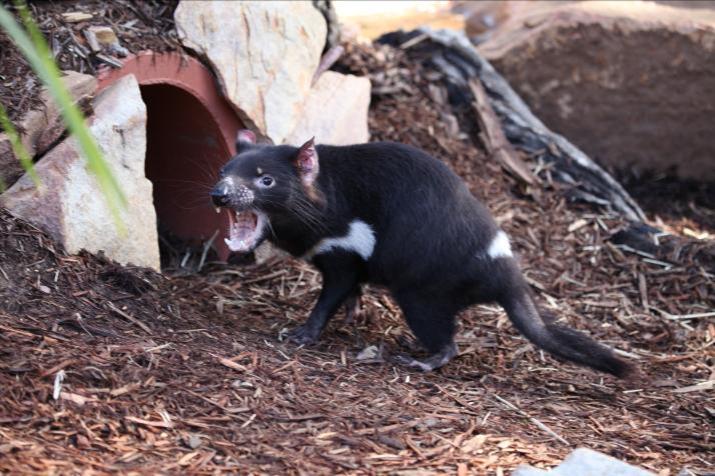Tasmanian Devil (Sarcophilus harrisii)
Habitat:
Tasmanian Devils are widespread in Tasmania and live in open Sclerophyll forests and mixed rainforests. They make their dens in hollowed logs, old wombat burrows and caves.
Description:
The Devil has a thick-set, squat build with a relatively large, broad head and short, thick tail. The fur is mostly or wholly black, but white markings often occur on the rump and chest. Body size varies depending on their diet and habitat. Adult males are usually larger than adult females. Large males can weigh up to 12kg, and stand about 30cm at the shoulder.
Status:
Endangered
Interesting facts:
- Devils are the world’s largest surviving carnivorous marsupial—carrying their young in a pouch for up to 16 weeks.
- Devils are nocturnal animals who sleep during the day and hunt/scavenge at night.
- Diet: Small mammals, birds, fish, frogs, reptiles and insects but will also eat rotting fruits and berries.
- Group structure: Solitary animals until mating season after which the male leaves the female to raise the young.
- Reproduction: Female is fertile at 2 years of age and will only breed 2-3 times in her life. After a 21 day gestation period she will give birth to between 20-30 young but only up to 4 young will survive as she only has 4 teats.
- Lifespan: 6-8 years.
- They make a loud hissing/screeching sound when stressed.
- When a devil feels threatened or excited its ears will turn red and will also emit an offensive odour.
- Eating behaviour: Will eat whole carcasses including bones and fur with very sharp, strong teeth and jaws that are as powerful as a Saltwater Crocodile.
- Today devils are facing extinction due to a disease known as Devil Facial Tumour Disease which causes terrible tumours around the Devil’s face.

Tasmanian Devil Population Distribution Map





